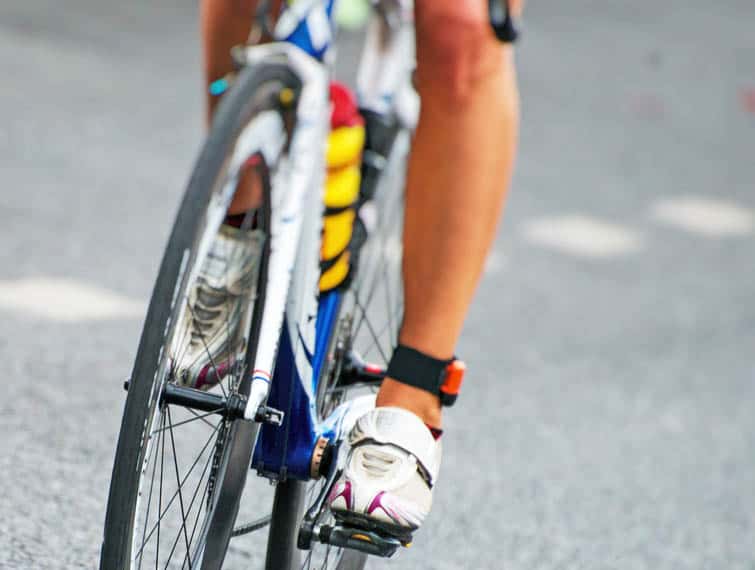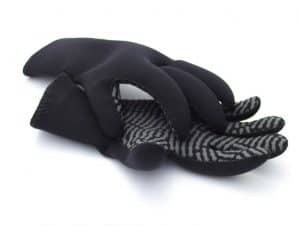Cyclists love the thrill of a long ride. Uphill, downhill, flat road, and off-road rides test and push the athletes’ cardio and legs to the limit. But cycling, like all sports, comes with potential injuries. A common ailment that athletes in high-impact sports get are shin splints.

A result of stress on your tibia or shinbone, this throbbing or aching on the front side of your legs is a condition also known as “medial tibial stress syndrome”.
What Are Shin Splints?
Shin splints is a common cause of pain in the muscles and connective tissue in the front of your lower leg, also called anterior tibialis tendonitis. Shin splints often occur when a person suddenly increases the intensity or duration of exercise on their shin muscles, which can lead to inflammation and pain on the part of the muscle that attaches to bone. Exercise-induced shin splints usually occur from running or forceful use on elliptical machines.
Is It Possible Cycling Causes Shin Splints?
The stress caused over time or all at once via leg force impact is what causes shin splints to occur. It’s a good thing that for the average bike rider, whether casual or competitive, cycling is usually a relatively low-impact sport. So it’s safe to say that cycling is quite unlikely to cause shin splints.
But avid bikers must still take precaution. As one of the most essential body parts of the sport, legs still gets stress from continuous, rigorous use. Thrill seekers might love a lot of uphill rides but doing this a little too often can contribute to shin stress, especially for beginner riders.
Why Do I Got Sore Shins After Cycling?
Sore shins after cycling can be caused by a number of factors. One of the most common causes is lack of flexibility in the ankles and calves. When these muscles are tight, they can put pressure on the shin bone, leading to discomfort. Another common cause of sore shins is overuse.
If you’re not used to cycling, your shins may get sore from all the extra work they’re doing. Finally, improper bike fit can also lead to sore shins. If your bike seat is too high or too low, it can cause pain in your shins.
Fun Outdoor Quiz
How to Heal Shin Splints?
If you want to hit the road more often, you have to devote periods of recovery every now and then. Lack of rest might still cause some level of aches and pains that push the shinbones sometimes beyond the threshold. Sure, long rides are heaven for the cardio, shedding pounds, or just chilling along the road. But you have to listen to your body when it wants to take a break.
Extreme long riders who are either beginners or just don’t give their legs time to take a breather run the risk of building up stress over time that might cause shin splints. The thrill of the long road is highly enticing, but your body will thank you more when you give it time to recover from the physical strain every now and then.
Shin Splint Ice Packs
The Shin Splint Ice Packs are a unique and easy to use product that can help with the relief of shin splints. The ice packs are made with a soft gel material that is comfortable to wear and helps gradually adapt to the cold, while the elastic hook and loop straps can be easily adjusted for a customized fit. Additionally, the ice gel cover helps prevent condensation from forming and dripping onto your skin.
Last update on 2024-04-25 / Affiliate links / Images from Amazon Product Advertising API
Calf Compression Sleeves
If you’re dealing with pain from shin splits, calf compression sleeves may be able to help. Made with a copper-infused nylon material, these sleeves work to pull electricity from your body and reduce pain. The 3D ergonomic design ensures that the sleeve stays in place with no slipping, and the compression helps to improve circulation and reduce pain and swelling.
Last update on 2024-04-25 / Affiliate links / Images from Amazon Product Advertising API
Can You Bike with Shin Splints?
This is a common question amongst the biking community, but the answer is not straightforward. Shin splints are a painful condition that usually affect runners and can be caused by too much exercise or improper shoes. Although biking does not put the same strain on the feet as running does, it’s still important to wear proper footwear and get a bike that fits your body type.
Will Cycling Make Shin Splints Worse?
Shin splints are common injuries among novice runners due to the repetitive impact on the tibia. The question of whether cycling will make shin splints worse is difficult to answer because there is no research published on the subject. One would need to determine if cycling exercises the same muscles as running and which muscles are more likely to be tired after cycling than running.
These painful and persistent injuries can be caused by many factors, including incorrect cycling position on the bike, too much or too little gear, and even poorly gripping the handlebars. Studies have shown that cycling on a flat surface does not necessarily lead to more shin splint problems than cycling on an uphill slope.
What to Do if You Get Shin Splints
In the event you somehow do get shin splints, it will usually just subside over the course of a week with rest. But if it persists, you may get a physical exam with your doctor. An X-ray or bone scan may be necessary if the pain is unbearable. But usually, a quick check-up will be enough for lesser pains.
If swelling is visible on your shin, you can also place ice or an icepack to ease the condition. It can help to ice it for 20-30 minutes every 3 to 4 hours for 2 to 3 days, or until the pain is gone.
Custom-made or premade shoe inserts can also be a big help support your foot arches whenever you pedal or stand.
What Activities Cause Shin Splints?
Shin splints are a common injury among athletes. Rarely found in non-athletes, shin splints are most often an overuse injury of the front part of the shin. Shin splints are caused by repetitive movement of the foot on hard surfaces without proper support to absorb shock, or from improper running technique.
In many cases, shin splints can be prevented with proper stretching and warming up before activity, as well as icing after activity.
How Long Do Shin Splints Last?
Shin splints are an injury that can last for a few weeks or months, depending on the severity. The pain is caused by the inflammation of the tissues surrounding the shinbone. If left untreated, shin splints could lead to more serious complications such as stress fractures. They often occur when running or playing sports that require repetitive use of the foot and ankle joint.
Conclusion
In conclusion, shin splints can occur for a variety of reasons, and the person who is experiencing them should pay attention to what they are doing and eating. If they are going to continue cycling, they should make sure their shoes have proper arch support and make note of any pain they experience.









